人教版高中英语必修四 Unit4 Body language-语法篇(学生版)
人教新课标英语必修4全册教案(Unit 4 Body Language)
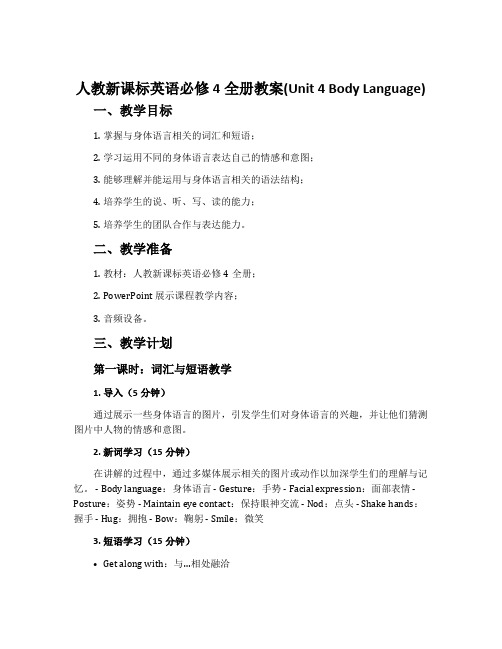
人教新课标英语必修4全册教案(Unit 4 Body Language)一、教学目标1.掌握与身体语言相关的词汇和短语;2.学习运用不同的身体语言表达自己的情感和意图;3.能够理解并能运用与身体语言相关的语法结构;4.培养学生的说、听、写、读的能力;5.培养学生的团队合作与表达能力。
二、教学准备1.教材:人教新课标英语必修4全册;2.PowerPoint 展示课程教学内容;3.音频设备。
三、教学计划第一课时:词汇与短语教学1. 导入(5分钟)通过展示一些身体语言的图片,引发学生们对身体语言的兴趣,并让他们猜测图片中人物的情感和意图。
2. 新词学习(15分钟)在讲解的过程中,通过多媒体展示相关的图片或动作以加深学生们的理解与记忆。
- Body language:身体语言 - Gesture:手势 - Facial expression:面部表情 - Posture:姿势 - Maintain eye contact:保持眼神交流 - Nod:点头 - Shake hands:握手 - Hug:拥抱 - Bow:鞠躬 - Smile:微笑3. 短语学习(15分钟)•Get along with:与…相处融洽•Make friends with:与…交朋友•Show respect for:对…表示尊敬•Be fond of:喜欢•Play a role:起作用•Be ashamed of:以…为羞耻•Be confident in:对…有信心•Have a positive attitude:持积极态度•Pay attention to:注意4. 听力练习(15分钟)播放相关录音,要求学生根据所听内容填写相应的单词或短语。
可以将答案呈现在 PowerPoint 上进行批改,同时让学生自己检查正确率。
5. 小结(5分钟)对所学的新词和短语进行小结。
鼓励学生积极参与,对不清楚的地方进行反复澄清。
第二课时:语法与句型教学1. 导入(5分钟)通过一个与身体语言有关的小故事或情景,引发学生们对身体语言的思考和讨论。
人教版高中英语必修4《Unit4Bodylanguage》教案

人教版高中英语必修4《Unit4Bodylanguage》教案人教版高中英语必修4《Unit 4 Body language》教案【一】教学准备教学目标1. 教学目标(1)知识目标:学生能掌握下列重点单词和短语的意义和用法:greet, represent, approach, expression, defend, misunderstand, adult, cheek, major, likely, in general。
能够表达一些Body language.(2)能力目标:学生能掌握基本的阅读理解方法:速读,寻读,归纳中心和查找细节。
(3)情感目标:学生了解不同国家和文化的身势语,激发学生学习这种语言的兴趣。
教学重难点教学重点和难点(1) 培养学生的阅读策略和技巧,让学生了解文章的细节知识和文章结构。
(2) 让学生合适地使用不同的身势语。
(3)课文中现在分词作定语和状语的长难句。
教学过程Step 1. Lead in(1)The teacher shows a question on screen:How can we communicate with others when we can’t speak ?Then ask a student to answer.设计说明:引出本单元的话题。
(2) The teacher shows some pictures on screen of some body language and ask some students to guess and discuss the meaning they stand for. 设计说明:引出本节课的题目。
Step 2. Fast reading1. Go through the passage quickly and find out the main idea of each paragraph.o Match the main idea of each para. with lines.(Para.1) A. Other examples of different greeting body language.(Para.2) B. Different people have different body language.(Para.3) C. Summary of body language.(Para.4) D. Meet the visitors at the airport.(Para.5) E. Examples of different greeting body language.2. Try to write down the main idea of the text.The text is mainly about different _____________ in different countries. In order to avoid difficulties in today’s world of cultural crossroads, we should ___________________________.设计说明:通过这个题目的练习,让学生掌握速读,先对文章段落大意有一个了解。
高中英语人教新课标必修四Unit-4Body-language教(学)案

Unit 4 Body language阅读课一、教学容Pre-reading (p.25); Reading (p.26); Comprehending (p.27)二、教学目标1. 能力目标●让学生通过阅读,能够理解并尊重不同区域的人的身体语言和其文化涵义。
●进一步训练学生推测、略读、找读、归纳容等阅读技巧;培养学生把握篇章中心容、归纳段落大意、获取关键信息、并且能针对阅读容表达自己的观点的能力。
2. 语言目标●重点词汇与短语greet prediction represent association dormitory canteen flight curiouscuriouly Colombia approach cheek defend defence majormisunderstanding Jordan dash adult spoken Spain Italy likely crossroadsdefend against be likely to in general●重点句子结构与用法Yesterday, another student and I, representing our university’s student association, wentto …After half an hour of waiting for their flight to arrive, I saw several young people enterthe waiting area looking around curiously.I stood for a minute watching them and then went to greet them.She stepped back appearing surprised and put up her hands, as if in defence.Then Akira Nagata from Japan came in smiling, together with Japanese student.When Darlene Coulon from France came dashing through the door, she recognizedTony Garcia’s smiling face.三、教学步骤步骤一读前1. 引导学生回顾Warming Up局部和听力材料的容,布置学生各组不同的任务归纳人和黑猩猩的相似之处。
高中英语必修4·Unit·4·Body·Language(using·language)(人教新课标)
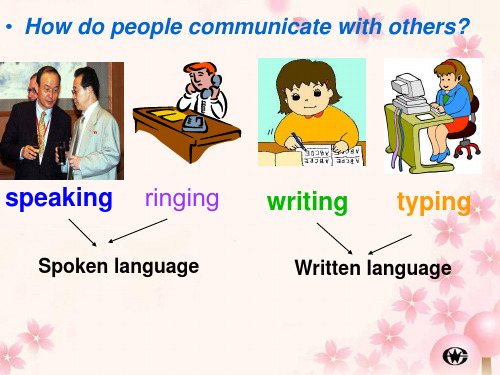
Columbia
Julia Smith
Britain
Akira Nagata
Japan
George Cook Ahmed Aziz Darlene Coulon
Canada Jordan France
Homework
Imagine that you are abroad but you know little local language. One day,you go to a restaurant to have something to eat. Try to use body language as much as possible to let the waiter know what you mean.
Matching the people and their different Part 2 ways of greeting (para2&3)
Mr Gaisses others twice on
each cheek
Julia Smith (Britain)
• 2. After an hour of waiting for their flight to arrive, I saw several young people enter the waiting area looking around curiously. F
• 3. I stood for a minute watching them and then went to greet them. T
• Careful reading para1
• Judge the following sentences T or F
• 1. Yesterday, another student and I, representing our university's student association, went to the Capital International Airport to meet this year's international students. T
人教版高中英语必修四 Unit4 Body language-语法篇(学生版)

Unit4 Body language语法篇____________________________________________________________________________________________________________________________________________________________________要求学生掌握本单元的重点语法----动词的-ing形式作定语和状语并能熟练运用相关语法知识解决相应类型的题。
一、动词的-ing形式由“动词原形+ing形式”构成,它既是现在分词形式,也是动名词形式。
v-ing能在句中作主语、宾语、表语、定语、宾语补足语和状语,但不能单独作谓语。
其时态和语态的变化为二、动词-ing形式的作用1.动词-ing形式作定语E.g. The sleeping baby looks very beautiful. (前置定语)这位正在睡觉的婴儿看起来太漂亮了。
E.g. The man sitting in the car is waiting for his daughter.(后置定语)坐在车里的男子正在等他的女儿。
E.g. The law being carried out is to ban drunken driving.(后置定语,强调正在被执行的法律)正在执行中的这则法律旨在禁止酒后驾驶。
名师点拨(1)现在分词短语作定语时通常后置,而单个的分词作定语时可置于被修饰词的前面,也可置于被修饰词的后面。
(2)现在分词的完成时的主动及被动形式均不作后置定语。
2.动词-ing形式作状语。
(1)作时间状语。
E.g. Working in the office, the clerk heard an explosion from the street.在办公室工作时,这位职员听到街上发出了爆炸声。
E.g. Having finished her homework, the girl was busy with the thing she likes.完成了家庭作业,女孩就忙于做她喜欢做的事情。
必修4-unit-4-body-language-语法讲解学习

=Although I know all this, I still want to see it for myself. 尽管我明白这些,我仍然想亲自去证明 一下。
5. 作伴随状语
V-ing 短语作伴随状语时,它所表达的动作 或状态,伴随着句子谓语动词的动作而发 生或存在的。意为“同时”
(2) Having finished his homework,the boy went out. (作状语)
完成家庭作业后,这个男孩就出去了。
V-ing 形式做状语的类型
• 1. 做时间状语 • 2. 做原因状语 • 3. 做条件状语 • 4. 做让步状语 • 5. 做伴随状语 • 6. 做结果状语 • 7. 做目的状语
(1) 现在分词作定语时多置于它所修饰的名词之 前;例如: He is a(n) attacking player. 他是一个攻击型的运动员。 (2) 分词短语用于它所修饰词的后面。 They lived a room facing the north thirty years ago. 三十年前,他住在一个朝北的房间里。
( 伴随状语)
2) Being poor, he couldn’t afford a TV set. (原因)
3) Working hard, you’ll surely succeed.
条件
4) The boy sat in front of the farm-
house, cutting the branch. 伴随
(1) 现在分词 (v+ing) 表进行意思和主动意思 例: I am doing homework. 我正在做家庭作业。 The flower is growing. 花朵在生长。
人教版高中英语必修4:Unit 4 Body Language
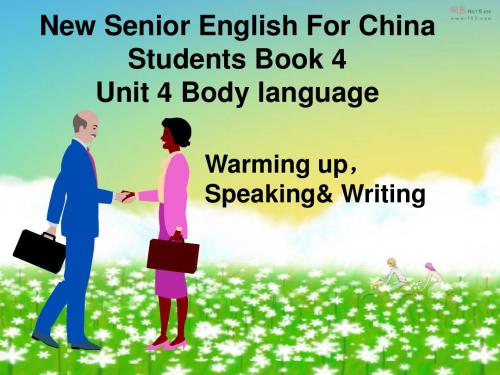
Let’s watch the flash!
What is body language ?
姿势;手势
Body language is a set of __g_e_st_u_r_es___, _b_o_d_y_肢_m体_o_动v_e作_m_e_n_t_s_ and _fa_c_ia_l_e_x_p_r_es_s_io_n.s
Game
1.I am full. 2. Please keep quiet ! 3. It is very hot today ! 4. I am strong! 5. Sorry, I can’t hear you. 6. I love you.
Part 2 Speaking 1.Look at the pictures of the story ,can you guess the correct order of the pictures below from their body language ? Write down your guesses.
You are very good.
/ Well done!
Do you know the meaning of the following body movements ?
I’m very excited.
Welcome.
Praying
Do you know the meaning of the following facial expressions ?
I should be more careful while driving in future.
What can you learn from this class?
必修4 unit 4 body language 语法

6. 做结果状语
V-ing 短语作结果状语时,是补充说明 主句中谓语动词发生的结果,通常位于 主句之后。 His parents died, leaving him an orphan. 他的父母死了,他成了孤儿。
7. 目的状语
V-ing 短语,作目的状语时,意为,“为 了” He studied hard, trying to pass the exam. 他努力学习,为了通过考试。
Hearing the news, she burst into tears.
当听到这条消息,她流出了泪水。
2. 做原因状语
V-ing做原因状语,意为,“因为,由于的意 思” Not knowing her address, I could only telephone her. = Because I didn't know her address,I could only
练一练
1) Four people entered the room looking
around in a curious way. = Four people enter the room and looked around in a curious wayng poor, he couldn’t afford a TV set.
5. ______ speaking, women live longer B than men. A. Judging from B. generally C. Supposing D. Taking everything into consideration
6. It has rained nonstop for ten days, completely _____ our holiday. A A. ruining B. to ruin C. ruined D. has ruined
高一英语人教版必修四Unit 4 Body Language Grammar 教案
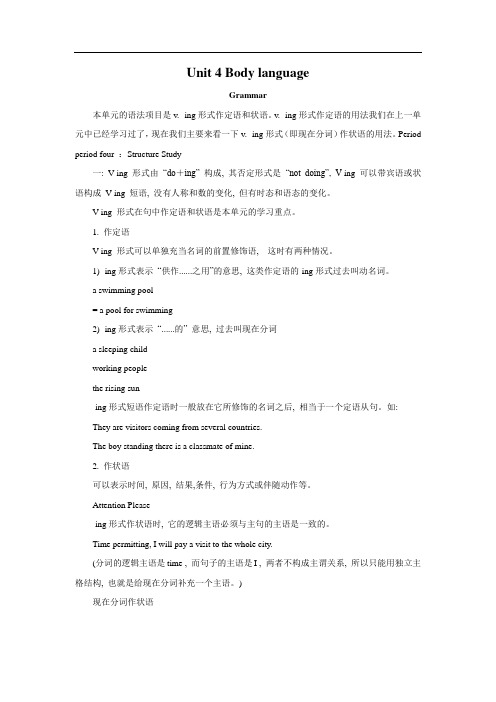
Unit 4 Body languageGrammar本单元的语法项目是v. -ing形式作定语和状语。
v. -ing形式作定语的用法我们在上一单元中已经学习过了,现在我们主要来看一下v. -ing形式(即现在分词)作状语的用法。
Period period four :Structure Study一: V-ing 形式由“do+ing” 构成, 其否定形式是“not doing”, V-ing 可以带宾语或状语构成V-ing 短语, 没有人称和数的变化, 但有时态和语态的变化。
V-ing 形式在句中作定语和状语是本单元的学习重点。
1. 作定语V-ing 形式可以单独充当名词的前置修饰语, 这时有两种情况。
1) -ing形式表示“供作......之用”的意思, 这类作定语的-ing形式过去叫动名词。
a swimming pool= a pool for swimming2) -ing形式表示“......的” 意思, 过去叫现在分词a sleeping childworking peoplethe rising sun-ing形式短语作定语时一般放在它所修饰的名词之后, 相当于一个定语从句。
如:They are visitors coming from several countries.The boy standing there is a classmate of mine.2. 作状语可以表示时间, 原因, 结果,条件, 行为方式或伴随动作等。
Attention Please-ing形式作状语时, 它的逻辑主语必须与主句的主语是一致的。
Time permitting, I will pay a visit to the whole city.(分词的逻辑主语是time , 而句子的主语是I , 两者不构成主谓关系, 所以只能用独立主格结构, 也就是给现在分词补充一个主语。
)现在分词作状语现在分词和分词短语可以在句子中作状语来修饰谓语动词或整个句子,表示动作发生的时间、原因、条件、结果、让步或伴随状况。
人教版高中英语必修四-第四单元-Body-language-知识点讲解

4. They had a large__m__a_jo_r_i_ty_ (major) over the other party at the last election.
4. 名词作宾语。
5. All our officers are trained
_t_o__d_e_fe_n_d_ (defensive) ourselves against knife attack. 5. 不定式表示目的。
3. __sp_e_a_k____ v.谈话,讲话 _s_p_e_e_c_h___ n. 发言 __sp__o_k_e_n__ adj.口语的
4. _d__ef_e_n_c_e___ n.防御,保卫 _d_e_f_e_n_d____ v. 防御,保卫 _d__ef_e_n_s_iv_e____ adj. 防御的,保卫的
6) A
3.The first person to arrive was Tony Garcia from Colombia, closely followed by Julia Smith from Britain. (Page 26) 第一个到达的是从哥伦比亚来的托尼·加西亚,紧随其 后的是英国的朱莉娅·史密斯。
They will be meeting at a major hotel 2
_w__it_h_ local business people and people 3_w__h_o_ represent the Chinese government. Four people enter looking around 4 _in_ a curious way. You do not want to disappoint your boss,and this is an 5_e_x_c_i_ti_n_g_ (excite) experience for you,So you stand watching and 6_l_is_t_e_n_in_g__ (listen).
新人教必修4 Unit4 Body language-Grammar
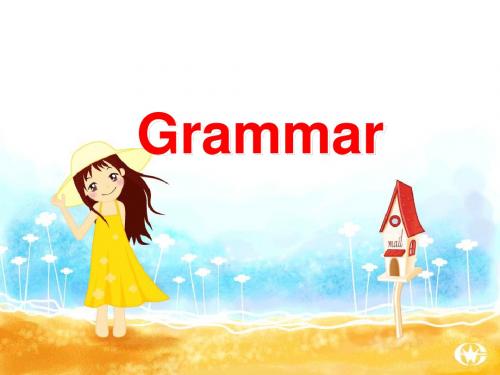
3. There are hundreds of visitors _____ C in front of the Art Gallery to have a look at Van Gogh’s paintings. A. waited B. to wait
C. waiting
D. wait
4. ______ , the more expensive the C camera, the better its quality. A. General speaking B. Speaking general C. Generally speaking D. Speaking generally
2. Whenever he was asked why he was late for class, he would answer carelessly, always ______ the same A thing. A. saying B. said C. to say D. having said
3)表方式、伴随情况地状语 :作伴随状语的分 词表示的动作,必须是主语的一个 动作,或是 与谓语所表示地动作(或状态)同时发生,或 是对谓语表示地动词(或状态)作进一步地补 充说明。
Eg. He sat on the sofa, watching TV.
(=He sat on the sofa, and watched TV.) Eg. They eat using the fingers of their right hands. (=They eat by using the fingers of their right hands.
Grammar quiz 语法小测
C 1. When _____ different cultures, we often pay attention only to the differences without noticing many similarities. A. compared B. being compared C. comparing D. having compared
高中英语 Unit 4 Body language语法学案 新人教版必修4
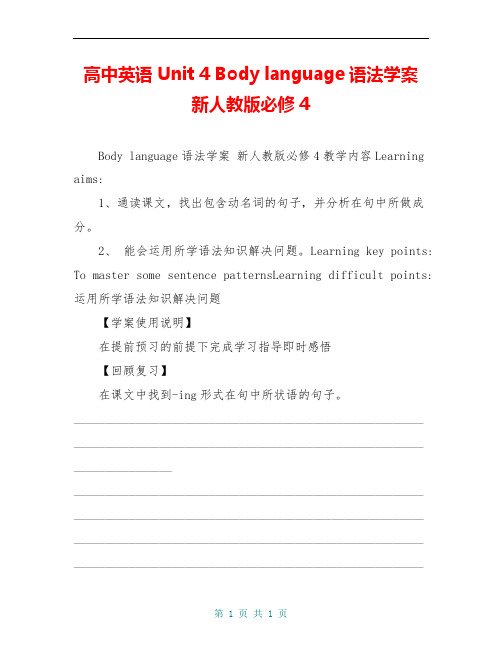
高中英语 Unit 4 Body language语法学案新人教版必修4Body language语法学案新人教版必修4教学内容Learning aims:1、通读课文,找出包含动名词的句子,并分析在句中所做成分。
2、能会运用所学语法知识解决问题。
Learning key points: To master some sentence patternsLearning difficult points: 运用所学语法知识解决问题【学案使用说明】在提前预习的前提下完成学习指导即时感悟【回顾复习】在课文中找到-ing形式在句中所状语的句子。
______________________________________________________________________________________________________________________________________________________________________________________________________________________________________________________________________________________________________________________________________________________________________________________________________________________________________________________________ _________________________________________________________ _________________________________________________________ ________________________【自主合作探究】动词-ing形式作状语动词-ing形式可以作状语,在句中表示时间、原因、结果、条件、让步、行为方式或伴随情况等。
人教必修4 Unit 4 Body language

Enjoy a song called Health song
OK
stop
silent/ quiet well done/ good
have a headache
postures 姿势
have a stomachache
gestures 手势
facial expressions 面部表情
body language 肢体语言
postures 姿势
other countries
communication: NO PROBLEM?
Any problems?
Capital International Airport
Task 1
Scan the text and answer the following questions. 1. How many international students are there in the passage? There are six students in the passage. 2. Who are they and where do they come from?
Who are they and whereபைடு நூலகம்do they come from?
Name
Tony Garcia
Country
Columbia Britain Japan Canada Jordan
Julia Smith Akira Nagata George Cook
Ahmed Aziz Darlene Coulon
Japan
Spain, Italy, South American countries France
新人教版高中英语必修4Unit 4 Body language

Unit 4 Body languageTeaching aims:1.TopicBody language; cultural differences and intercultural communicationeful words and expressions:Nouns: check, stranger, action, comedy, expression, agreement, chest, gesture, adultVerbs: approach, represent, introduce, touch, express, nod, avoid, misunderstanding, yawn, punish Adjectives: major, local, curious, spoken, general, similar, facialExpressions: be likely to, at ease3.Functional items:1. Prohibition and warningsDo not smoke here.Watch out! A car is coming!You may not….Don’t slip.Always stay….Be careful when…Don’t enter here.Don’t sit here.Stop!Be quiet.2. ObligationYou /He must…You should never…4.Grammar1). The –ing form as the attribute.They are visitors coming from several countries.… and this is an exciting experience for you…His nose touches Mr. Cook’s moving hand….2). The –ing form as the attributeFour people enter looking around in a curious way.She arrives hurrying, recognizes Mr. Garcia’s smiling face…Teaching proceduresPeriod 1 SpeakingStep 1. Warming-upT shows some pictures on screen. These pictures are from the Evening Party Celebrating the coming Lunar New Year ofthe Rooster of 2005.Step 2. SpeakingTask 1.Ss look at the screen and try to explain the meaning of the pictures.Suggested answers:Task 2. Ss finish warming up on page 25.Suggested answers:Time forfunTask 3.Ss ingroups offour. Onethinks ofasituation and asks the others to show some actions using bodylanguage. When the one chooses the action that is most likely,it is his or her turn to think of some other situation forthe others to show the actions so that the game may go on fora few rounds.Step 4. TalkingTask 4. Get the Ss to work in pairs. The situation is thatyou are worried about Lin Pei, who is not friendly any more,and does not want to talk to you or her other friends. Sheseems to be sad. She stays alone. She is not doing her homeworkand the teacher is not pleased with her. She doesn’t seemto care about how she looks and behaves.Step 5. Role playTask 5. Ss finish the speaking task on page 67.Period 2. ReadingStep 1. Warming upTask 1. Ss try to answer the following questions:1.What is the purpose of language?2.Do people send each other messages only by words? Whatother ways can be used?3.How can you tell if someone is sad even if they do notspeak?4.Give an example of how you can communicate a feeling tosomeone who does not speak your language.Step 2. ReadingTask 2: Ss read and answer the following questions:1.What’s the main idea of the passage?2.How many parts can the passage be divided into?3.What’s the main idea of each part?4.What can we learn from the passage?A.Never too old to learn.B.Do as the Romans do.C.Four eyes see more than two.D.Every country has its own customs.5.“Mr Garcia approaches Ms Smith,…” the underlined wordhas the same meaning as __________.A.all the approaches to the palace were guarded bytroops(军队).B.The club has made an approach to a local business firmfor sponsorship(资助).C.The time is approaching when we must think about buyinga new house.D.I find him difficult to approach.Task 3: Ss read and fill the following chart:Step 4. After- readingTask 4: Ss in groups and discuss:Suppose your friend is to attend an English corner. Many students coming from different countries will be present as well. She is excited but nervous because she doesn’t know how to make others accept her. What should she do then? Period nguage learningStep 1. RevisionSs retell the text with their own words.Text retelling:My boss has sent me to Pudong Airport to meet some business people from many parts of the world, who are interested in the development of the economy in China.The first one to arrive is Mr. Garcia from Columbia with Julia Smith, a British lady, following behind closely. I introduce them to each other and I’m surprised to see Mr. Garcia come up to Ms. Smith, touch her shoulder and kiss her on the cheek while Ms. Smith steps back appearing surprised. Just then, in comes a visitor from Japan, smiling at the time when the Canadian, George Cook reaches out his hand to him. It happens that Mr. Cook’s hand touches the Japanese’s nose as he bows and they both apologize.So you see, people from different cultures may not greet others in the same way. English people usually do not stand very close to others or touch strangers as people from Spain, Italy and South American countries do. Most people around the world shake hands when they meet while Japanese people will bow. People from Jordan stand quite close to other men and shake hands, but they simply nod to women. And French people shake hands and kiss others on the cheeks.In a word, body language varies in different cultures and is widely used in communication.Step 2. The –ing form as the Attribute and AdverbialAsk Ss to pick out the sentences with v-ing in them and underline them:1.They are visitors coming from several other countries…2.Four people enter looking around in a curious way.3.This is an exciting experience for you, so you standwatching and listening.4.You see her step back appearing surprised, and take a fewsteps away from Mr. Garcia.5.The visitor from Japan comes in smiling at the same timeas George Cook from Canada.6.His nose touches Mr. Cook’s moving hand, and they bothapologize.7.…, nor are they comfortable touching strangers or beingtoo close or too far away.8.…, they also express their feelings using unspokenlanguage through keeping physical distance, actions or posture.9.Most people around the world now greeting each other byshaking hands…10.She arrives hurrying, recognizes Mr. Garcia’s smilingface, and then they shake hands…11.It is an interesting study and can help you avoiddifficulty in communication.12.In most countries, nodding the head up and down showsagreement, while shaking the head means that you do not agree…13.If you stand holding your arms across your chest, you maybe protecting yourself…14.If you sit looking at and turn toward the person you aretalking to…15.We show respect for people by using different gestures.16.Children are taught that looking directly at an adult isnot good behavior.17.…so it is an amazing thing that we understand each otheras well as we do.18.Showing our hands means that we are not armed.19...the Western custom of shaking hands is used,20.Japanese people might cover one hand with the other and,depending on whom they are greeting, how slightly or quite low.Step 3. Language points1. make: make sb do sth.Make oneself doneMake sth to doHis father’s death made him leave school.He was made to leave school by his father’s death.I had to speak loud to make myself heard.They had to make a fire to warm themselves.2. prepare: v. preparation: n.prepare for:be prepared to do3. disappoint: v. disappointment: n.disappointed / disappointing: adj.4. closely /closeShe sat close against the wall.Please listen closely.Come close to doing sth.= almost doing sth.5. Not all cultures greet each other the same way, nor are they ….表否定的not放在句首,该句用倒装语序。
人教版高中英语读后续写教学方法——以Unit_4_Body_Language为例
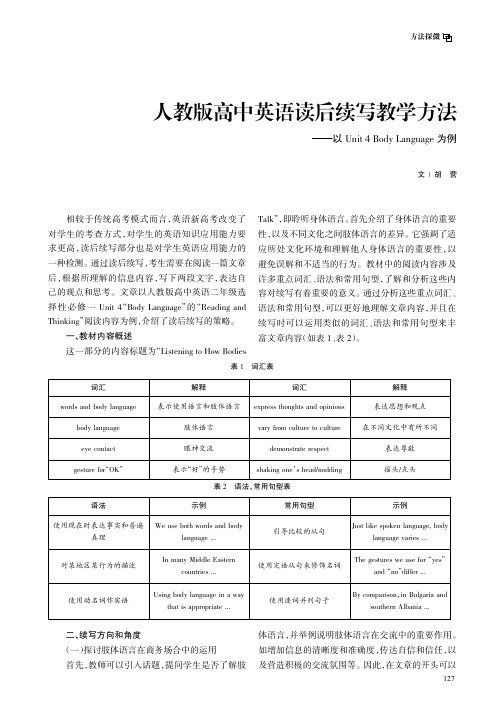
方法探微人教版高中英语读后续写教学方法———以Unit4Body Language为例文|胡营相较于传统高考模式而言,英语新高考改变了对学生的考查方式,对学生的英语知识应用能力要求更高,读后续写部分也是对学生英语应用能力的一种检测。
通过读后续写,考生需要在阅读一篇文章后,根据所理解的信息内容,写下两段文字,表达自己的观点和思考。
文章以人教版高中英语二年级选择性必修一Unit4“Body Language”的“Reading and Thinking”阅读内容为例,介绍了读后续写的策略。
一、教材内容概述这一部分的内容标题为“Listening to How Bodies Talk”,即聆听身体语言。
首先介绍了身体语言的重要性,以及不同文化之间肢体语言的差异。
它强调了适应所处文化环境和理解他人身体语言的重要性,以避免误解和不适当的行为。
教材中的阅读内容涉及许多重点词汇、语法和常用句型,了解和分析这些内容对续写有着重要的意义。
通过分析这些重点词汇、语法和常用句型,可以更好地理解文章内容,并且在续写时可以运用类似的词汇、语法和常用句型来丰富文章内容(如表1、表2)。
二、续写方向和角度(一)探讨肢体语言在商务场合中的运用首先,教师可以引入话题,提问学生是否了解肢体语言,并举例说明肢体语言在交流中的重要作用。
如增加信息的清晰度和准确度,传达自信和信任,以及营造积极的交流氛围等。
因此,在文章的开头可以表1词汇表词汇解释词汇解释words and body language表示使用语言和肢体语言express thoughts and opinions表达思想和观点body language肢体语言vary from culture to culture在不同文化中有所不同eye contact眼神交流demonstrate respect表达尊敬gesture for“OK”表示“好”的手势shaking one’s head/nodding摇头/点头表2语法、常用句型表语法示例常用句型示例使用现在时表达事实和普遍真理We use both words and bodylanguage...引导比较的从句Just like spoken language,bodylanguage varies...对某地区某行为的描述In many Middle Easterncountries...使用定语从句来修饰名词The gestures we use for“yes”and“no”differ...使用动名词作宾语Using body language in a waythat is appropriate...使用连词并列句子By comparison,in Bulgaria and southern Albania...127教学·策略这样写:“Body language plays an important role in business communication.Good body movements can convey con-fidence and trust to the other person,and create a good atmosphere.”其次,教师可以创设示例情境或让学生观察真实商务交流案例,帮助他们理解肢体语言在商务场合中的实际应用。
- 1、下载文档前请自行甄别文档内容的完整性,平台不提供额外的编辑、内容补充、找答案等附加服务。
- 2、"仅部分预览"的文档,不可在线预览部分如存在完整性等问题,可反馈申请退款(可完整预览的文档不适用该条件!)。
- 3、如文档侵犯您的权益,请联系客服反馈,我们会尽快为您处理(人工客服工作时间:9:00-18:30)。
Unit4 Body language语法篇____________________________________________________________________________________________________________________________________________________________________要求学生掌握本单元的重点语法----动词的-ing形式作定语和状语并能熟练运用相关语法知识解决相应类型的题。
一、动词的-ing形式由“动词原形+ing形式”构成,它既是现在分词形式,也是动名词形式。
v-ing能在句中作主语、宾语、表语、定语、宾语补足语和状语,但不能单独作谓语。
其时态和语态的变化为二、动词-ing形式的作用1.动词-ing形式作定语E.g. The sleeping baby looks very beautiful. (前置定语)这位正在睡觉的婴儿看起来太漂亮了。
E.g. The man sitting in the car is waiting for his daughter.(后置定语)坐在车里的男子正在等他的女儿。
E.g. The law being carried out is to ban drunken driving.(后置定语,强调正在被执行的法律)正在执行中的这则法律旨在禁止酒后驾驶。
名师点拨(1)现在分词短语作定语时通常后置,而单个的分词作定语时可置于被修饰词的前面,也可置于被修饰词的后面。
(2)现在分词的完成时的主动及被动形式均不作后置定语。
2.动词-ing形式作状语。
(1)作时间状语。
E.g. Working in the office,the clerk heard an explosion from the street.在办公室工作时,这位职员听到街上发出了爆炸声。
E.g. Having finished her homework,the girl was busy with the thing she likes.完成了家庭作业,女孩就忙于做她喜欢做的事情。
名师点拨动词-ing形式一般式常表示该动作与句子谓语动作同时发生,而动词-ing形式的完成式则表示该动作发生在谓语动作之前。
(2)作原因状语。
E.g. Lacking enough money,they had to give up the plan.由于缺乏足够的资金,他们只好放弃了这项计划。
(3)作条件状语。
E.g. Getting the chance to study abroad,he will try his best to improve himself.如果得到到国外学习的机会,他将尽力提升自己。
(4)作结果状语。
E.g. He failed to work out the last question in the math paper,making him lose the chance to enter his ideal university.他没有能够做出数学试卷上的最后一道题,致使他失去了上理想大学的机会。
(5)作让步状语。
E.g. Working hard all the day,he still felt energetic.尽管努力工作了一整天,他仍然感到精力充沛。
(6)作伴随状语。
E.g. The girls sat together in front of the house,talking and laughing.女孩们一起坐在屋前,又说又笑。
(7)作方式状语。
E.g. They greeted each other bowing to each other.他们鞠躬彼此打招呼。
名师点拨(1)动词-ing形式作状语时相当于与之对应的状语从句,并且可互相转换。
(2)动词-ing形式作伴随状语时,则可转化成并列谓语。
E.g. Knowing what to do next,he set out to do it at once.=When he knew what to do next,he set out to do it at once.当明白下一步要做什么时,他立刻开始着手做起来。
E.g. The guide showed the visitors around the pictures explaining the background of each picture.=The guide showed the visitors around the pictures and explained the background of each picture.导游领着游客参观这些图画,并解说每一幅画的背景。
三、难点突破1.单个的动词-ing形式作定语置于被修饰词的前面时,注意下面的两种情况对比。
E.g. The old man needs a walking stick. =The old man needs a stick used for walking.(表示用途)老人需要一把用于行走的手杖。
E.g. There are many people on the top of the mountain now who are enjoying the rising sun. =Thereare many people on the top of the mountain now who are enjoying the sun which is rising.(强调动作)现在山顶上有很多人在欣赏正在升起的太阳。
2.独立主格。
现在分词作状语,有时它也可以有自己独立的逻辑主语,这种结构称为独立主格结构,通常用来表示伴随的动作或情况,也可以表示时间、原因或条件等。
E.g. Weather permitting,we will go out for an outing.如果天气允许,我们会出去远足。
E.g. The paper having been finished,the student handed it in.做完试卷之后,这位学生把它交了上去。
3.评论性状语。
有些动词-ing形式作状语,在句中没有逻辑上的主语而独立存在,用来修饰主句,表明说话者的态度、观点等,被称为评论性状语或悬垂分词。
常见的有generally/strictly/frankly speaking,judging from,considering,supposing,providing等。
E.g. Judging from what he has said,he is a doctor.根据他的话判断,他是位医生。
E.g. Considering that the old man is old,he needs looking after.考虑到老人老了,他需要被照顾4.动词-ing形式作状语时,常将否定副词not置于分词前面。
E.g. Not having finished the work,they had to work extra hours.由于没有完成工作,他们只好加班。
5.状语从句转化为非谓语作状语时,若从句的主语与主句的主语一致,从句谓语含有be动词时,可保留从句的引导词。
E.g. When getting to the top of the mountain,they found the sun was rising.当他们到达山顶时,发现太阳正在升起。
6.动词-ing形式与过去分词的区别(1)语态不同:v.-ing形式表示主动概念,与相关的名词或代词之间构成一种“主谓关系”。
而过去分词表示被动概念,与相关的名词或代词构成一种“动宾关系”。
(2)时间不同:v.-ing形式表示“正在进行的动作”;过去分词表示“已完成的动作”。
E.g. Seeing from the hill,you will see the beautiful city.在山上看,你会看到美丽的城市。
E.g. Seen from the hill,the beautiful lake is like a big mirror.从山上看,那个美丽的湖就像一面大镜子。
【巧学助记】分词短语记忆口诀分词作状语,主语是问题;逗号前后两动作,共用一主语;主语找出后,再来判关系;主动用-ing,被动用-ed;having done表先后,千万要牢记例1.(2019福建泉州期中)He waited at the gate of the hotel all the time,______to run into his favorite pop singer.A. hopingB. to hopeC. having hopedD. hoped例2.(2019大纲全国)Today there are more airplanes_______ more people than ever before in the skies.A. carryB. carryingC. carriedD. to be carrying例3.(2019福建)________the past year as an exchange student in Hong Kong,Linda appears more mature than those of her age.A. SpendingB. SpentC. Having spentD. To spend例4.(2019山东济宁期中)______money,his parents couldn’t send him to university.A. LackedB. Lacking ofC. Lacked inD. Lacking例5.(2019辽宁锦州月考)Titanic 3D moved all audience to tears once again,________ our attention to Cameron’s films and the definition of true love.A. turningB.to turnC. turnedD. being turned基础演练句型转换(用非谓语动词结构变换句子)1. The storm left and has caused a lot of damage to this area.The storm left,__________________________ this area.2. Be careful when you cross the road.Be careful when________________.3. The building that is being built now is our new school.The building ______________ is our new school.4. Who is the man that is reading over there?Who is the man________________?5. Because she did not know that the traffic accident happened to her husband,she was waiting for him to have supper.______________that the traffic accident happened to her husband,she was waiting for him to have supper.6. Because he is a student,he should study hard.______________,he should study hard.7. Even though the farmer works hard on the farm all the year round,he still can't become rich.________________all the year round,the farmer still can't become rich.8. The boy sat on the sofa and watched TV.The boy sat on the sofa,____________.巩固提高用所给动词的适当形式填空1. The man ________________ (visit) Japan is my uncle.2. ____________ (see) no one at home,I decided to come again.3.________ (hear) the good news,he jumped with joy.4.________ (walk) in the street,I saw a friend of mine.5.________________ (talk and smile),they went into the room.6. The mother died,________ (leave) a lot of money for her children.7.________ (see) from the top of the hill,we can see our beautiful school.8. Many people ________ (be) absent,they decided to put the meeting off.9.________ (not have) heard from her son for a long time,the mother worried a great deal.10.________________ (finish) his work,Henry went home.一、单项语法填空1. He sat on a chair under the shade of the tree,________ (read) a novel.2. The boys and girls are walking along the street,each________ (wear) a small yellow cap.3. When I reached home,my husband was lying on the floor,________ (entertain) the kids with toys.4. is the largest English site in China,________ (provide) news,business information and learning materials.5.China became the 143rd member of the WTO on December 11,2019,thus ________(realize) its 15-year wish to join the global trade body.6. Do you know who is the patient ________ (operate) on now?7.________ (complete) the project on time,the staff are having a party to have a celebration.8.________ (fail) to reach them on the phone,we sent an email instead.9.________ (come) from a mountain village,he couldn't afford a house in Shanghai.10. ________ (spend) the past year as an exchange student in Hong Kong,Linda appears more mature than those of her age.二、单项选择1._______with so much trouble,we failed to complete the task on time.A. FacedB. FaceC. FacingD. To face2. At present,he is a student at Zhejiang University,_______ for a degree in computerA. studiesB. studyingC. to have studiedD. having studied3.--How do you find the furniture I bought?--_______.But _______what you bought with the one we had,I don’t think it worth the money.A .Fascinating./ compared B. Fascinating/ comparingC. Fascinated/ to compareD. Fascinated / compared4.To some people,“spiritual health” is a very abstract concept,_______ many unexplainable elements.A. containedB. having containedC. being containedD. containing5.There are many tall old trees_______ in and around our school.A. stoodB. to standC. standingD. being standing__________________________________________________________________________________________________________________________________________________________________一、单项选择1. My good performance in the job interview left me ______ about my future and about what I can do here.A. puzzledB. sensitiveC. optimisticD. embarrassed2. While waiting for the opportunity to get______,Henry did his best to perform his duty.A. promoteB. promotedC. promotingD. to promote3. There is a note pinned to the door______ when the shop will open again.A. sayingB. saysC. saidD. having said4. It’s standard practice for a company like this one______ a security officer.A. employedB. being employedC. to employD. employs5. Last night,there were millions of people ______ the opening ceremony live on TV.A. watchB. to watchC. watchedD. watching6. There are still many problems ______ before we are ready for a long stay on the Moon.A. solvingB. solvedC. being solvedD. to be solved7. The film star wears sunglasses. Therefore,he can go shopping without ______.A. recognizingB. being recognizedC. having recognizedD. having been recognized8. ______ the past year as an exchange student in Hong Kong,Linda appears more mature than those of her age.A. SpendingB. SpentC. Having spentD. To spend9. For those with family members far away,the personal computer and the phone are important in staying______.A. connectedB. connectingC.to connectD.to be connected10. Children,when______ by their parents,are allowed to enter the stadium.A. to be accompaniedB. to accompanyC. accompanyingD. accompanied11. ______ your own needs and styles of communication is as important as learning to convey your affection and emotions.A. UnderstandingB. To be understoodC. Being understoodD. Having understood12. There is no greater pleasure than lying on my back in the middle of the grassland,______ at the night sky.A. to stareB. staringC. staredD. having stared13. ______ ourselves from the physical and mental tensions,we each need deep thoughtand inner quietness.A. Having freedB. FreedC. To freeD. Freeing14. His lecture______,a lively question-and-answer session followed.A. being givenB. having givenC. to be givenD. having been given15. When it comes to ______ in public,no one can match him .A. speakB. speakingC. being spokenD. be spoken16. ______ nearly all our money,we couldn’t afford to stay at a hotel.A. Having spentB. To spentC. SpentD. To have spent17. He is thought ______ foolishly .Now he has no one but himself to blame for losing the job .A. to actB.to have actedC. actingD. having acted18. Toady there are more airplanes ______ more people than ever before in the skies.A. carryB. carryingC. carriedD. to be carrying19. It’s quite hot today. Do you feel like ______ for a swim?A. to goB. going C go D. having gone20. ______ the difficult maths problem,I have consulted Professor Russell several timesA. Working outB. Worked outC. To work outD. Work out二、阅读理解、AThe baby monkey is much more developed at birth than the human baby. Almost from the moment it is born,the baby monkey can move around and hold tightly to its mother. During the first few days of its life the baby will approach and hold onto almost any large,warm,and soft object in its environment,particularly if that object also gives it milk. After a week or so,however,the baby monkey begins to avoid newcomers and focuses its attentions on “mother”—the real mother or the mother-substitute(母亲替代物).During the first two weeks of its life warmth is perhaps the most important psychological(心理的)thing that a monkey mother has to give to its baby. The Harlows,a couple who are both psychologists,discovered this fact by offering baby monkeys a choice of two types of mother-substitutes——one covered with cloth and one made of bare wire. If the two artificial mothers were both the same temperature,the little monkeys always preferred the cloth mother. However,if the wire model was heated,while the cloth model was cool,for the first two weeks after birth the baby monkeys picked the warm wire mother-substitutes as their favorites. Thereafter they switched and spent most of their time on the more comfortable cloth mother.Why is cloth preferable to bare wire? Something that the Harlows called contact(接触)comfort seems to be the answer,and a most powerful influence it is. Baby monkeys spend much of their time rubbing against their mothers’ skins,putting themselves in as close contact with the parent as they can. Whenever the young animal is frightened,disturbed,or annoyed,it typically rushes to its mother and rubs itself against her body. Wire doesn’t “rub” as well as does soft cloth. Prolonged(长时间的)“contact comfort”with a cloth mother appears to give the babies confidence and is much more rewarding to them than is either warmth or milk.According to the Harlows,the basic quality of a baby’s love for its mother is trust. If the baby is put into an unfamiliar playroom without its mother,the baby ignores the toys no matter how interesting they might be. It screams in terror and curls up into a furry little ball. If its cloth mother is now introduced into the playroom,the baby rushes to it and holds onto it for dear life. After a few minutes of contact comfort,it obviously begins to feel more secure. It then climbs down from the mother-substitute and begins to explore the toys,but often rushes back for a deep embrace(拥抱)as if to make sure that its mother is still there and that all is well. Bit by bit its fears of the new environment are gone and it spends more and more time playing with the toys and less time holding onto “its mother.”1. Psychologically,what does the baby monkey desire most during the first two weeks of its life?A. WarmthB. MilkC. ContactD. Trust2. After the first two weeks of their life,baby monkeys prefer the cloth mother to the wire mother because the former is________.A. larger in sizeB. closer to themC. less frightening and less disturbingD. more comfortable to rub against3. What does the baby monkey probably gain from prolonged “contact comfort”?A. AttentionB. SoftnessC. ConfidenceD. Interest4. It can be inferred that when the baby monkey feels secure,________.A.it frequently rushes back for a deep embrace when exploring the toysB.it spends more time screaming to get rewardsC.it is less attracted to the toys though they are interestingD.it cares less about whether its mother is still around5. The main purpose of the passage is to________A. give the reasons for the experimentB. present the findings of the experimentC. introduce the method of the experimentD. describe the process of the experimentBFear may be felt in the heart as well as in the head,according to a study that has found a link between the cycles of a beating heart and the chance of someone feeling fear.Tests on healthy volunteers found that they were more likely to feel a sense of fear at the moment when their hearts are contracting(收缩)and pumping blood around their bodies,compared with the point when the heartbeat is relaxed. Scientists say the results suggest that the heart is able to influence how the brain responds to a fearful event,depending on which point it is at in its regular cycle of contraction and relaxation.Sarah Garfinkel at the Brighton and Sussex Medical School said: “Our study shows for the first time that the way in which we deal with fear is different depending on when we see fearful pictures in relation to our heart.”The study tested 20 healthy volunteers on their reactions to fear as they were shown pictures of fearful faces. Dr Garfinkel said,“The study showed that fearful faces are better noticed when the heart is pumping than when it is relaxed. Thus our hearts can also affect what we see and what we don’t see—and guide whether we see fear.”To further understand this relationship,the scientists also used a brain scanner(扫描仪)to show how the brain influences the way the heart changes a person’s feeling of fear.“We have found an important mechanism by which the heart and brain ‘speak’ to each other to change our feelings and reduce fear,” Dr Garfinkel said.“We hope that by increasing our understanding about how fear is dealt with and ways that it could be reduced,we may be able to develop more successful treatments for anxiety disorders,and also for those who may be suffering from serious stress disorder.”1. What is the finding of the study?A. One’s heart affects how he feels fear.B. Fear is a result of one’s relaxed heartbeat.C. Fear has something to do with one’s health.D. One’s fast heartbeats are likely to cause fear.2. The study was carried out by analyzing________.A. volunteers’ heartbeats when they saw terrible picturesB. the time volunteers saw fearful pictures and their health conditionsC. volunteers’ reactions to horrible pictures and data from their brain scansD. different pictures shown to volunteers and their heart-brain communication3. Which of the following is closest in meaning to “mechanism” in Paragraph 6?A. Order.B. System.C. Machine.D. Treatment.4. This study may contribute to________.A. treating anxiety and stress betterB. explaining the cycle of fear and anxietyC. finding the key to the heart-brain communicationD. understanding different fears in our hearts and heads。
